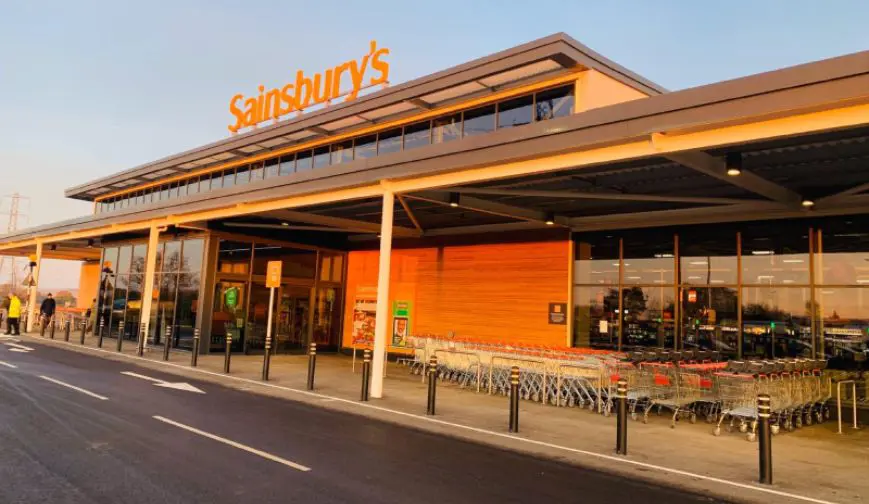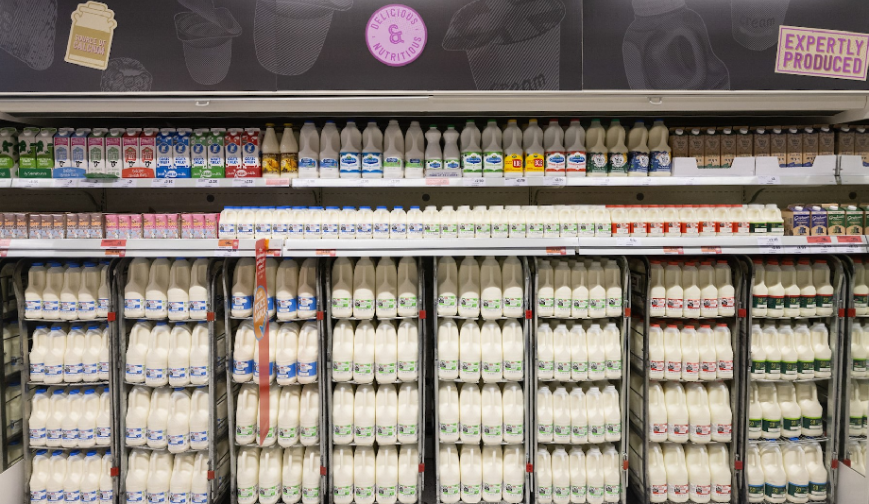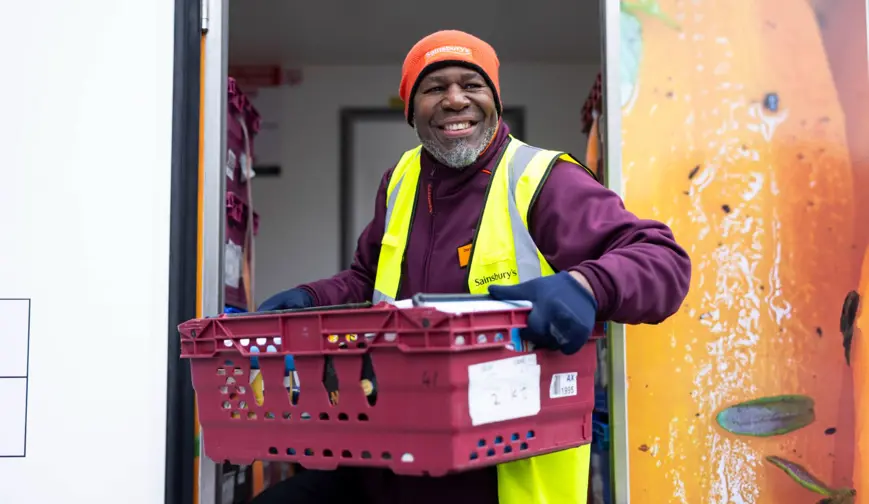50% reduction in surplus food sent to anaerobic digestion by 2030
Globally, around 30% of total food produced is either lost or wasted and with food insecurity rising we need to act. We are working hard to help customers make more informed choices about the food eat - and the food that is wasted, supporting our communities with surplus from our stores to help more people access good food, everyday, and working with our farmers and suppliers to reduce food waste across our supply chain or reuse waste as feed for animals. Because at Sainsbury’s we believe that good food shouldn’t go to waste.
Our ambition
Our progress and highlights
tonnes of surplus food was saved from going to waste in 24/25
meals were delivered to people and communities in need in 24/25
more surplus food redistributed to communities versus our 2019/20 baseline
donation target introduced in store
Our approach
Reducing waste starts with how we develop, design and create our products in partnership with our suppliers, growers and manufacturers. From reviewing our product specifications to maximising crop yields we have been able to develop new and popular ranges such as Stamford Street offering affordable food to customers whilst reducing food waste.
We are working with selected suppliers across different categories to understand opportunities to bridge the gap between food waste and food needs across the UK. We are using deep dive projects in high food waste areas to extract learnings and apply to other value chains.
We encourage suppliers to set and align their own food waste reduction ambitions and have clear policies in place providing guidance on the redistribution of surplus food and support industry wide initiatives such as Alliance Food Sourcing to tackle food waste across the supply chain.
Preventing food waste from occurring is our priority, and we are exploring ways to address this across our organisation. We work hard to maximise our product shelf life through efficient ordering, life optimisation and by leveraging the most appropriate packaging to maintain quality and freshness. We leverage technology to improve order accuracy and maximise sell through such as intelligent automation to identify on-shelf stock gaps to machine learning models to optimise mark downs on near-dated products. A new machine learning model will optimise markdowns on near-dated products, aiming to reduce waste costs and improve colleague efficiencies.
In Autumn, we launched a regional trial to improve compliance and increase performance around redistribution in our stores by giving Reducing waste Our target 50% reduction in surplus food sent to anaerobic digestion by 2030 Our future priorities We remain as committed as ever to accelerating our action on food waste and building on the progress to date. We will continue to focus on preventing food waste from occurring in the first place through ongoing improvements to our supply and demand planning. For the surplus food that does occur in our own operations, we will continue to maximise redistribution to charities and the local community. In support of this, we will work closely with stores across our estate to drive progress on our new company wide food surplus target and roll out training to empower our colleagues to drive compliance and progress.
Ongoing engagement with our suppliers remains key in supporting them to measure and report on their food waste and redistribute surplus where possible. stores access to a new food surplus reporting dashboard. This provided a benchmark to aim for and showed relevant data on how individual stores were performing, how they compared with other stores in the region and highlighted opportunities where more could have been donated across eligible food categories. We updated store procedures and guidance to support colleagues with clear actions on how to donate more surplus food. We highlighted the stores with best-in-class performance to help incentivise improved progress. At the end of the trial, we saw a significant increase in compliance and have since launched a new company-wide food surplus target to drive an increase in the donation of eligible products by the end of 2025.
We know that a significant proportion of food waste occurs in customers’ homes. That’s why we take a proactive approach to help households waste less starting with clear and consistent product labelling, aligned to industry best practice, to support safe storage and longer enjoyment of food. We’ve also made deliberate moves to remove multibuy promotions that can lead to over-purchasing, introduced loose produce options to give customers more control over quantities, and designed packaging that balances freshness with recyclability. These are all part of our ongoing commitment to help customers make informed choices and reduce waste at home.
We again stepped on our approach to rethinking ‘use by’ labelling based on best practice guidance, and in September 2023 became the largest UK retailer to remove all ‘use by’ dates on our own-brand milk (including all fresh and organic milk sold across England, Scotland and Wales), instead moving to ‘best before’ guidance, which helps customers reduce food waste in their own homes. This move impacts over 730 million pints of milk sold annually.
We also utilise customer campaigns aimed at educating customers on food waste and changing behaviours, and supporting nationwide events such as Food Waste Action Week.
We’re driven by our purpose and committed to making sure that everyone can access good food, whoever they are and whatever their circumstance but we know that unfortunately the gap between those who can easily access good food and those who can’t continues to widen, and millions across the UK face food insecurity.
In 1998, we launched our Food Donation Programme, where stores partner with local organisations operating both Front of Store (customers donations into donation points in stores) and Back of Store (donating surplus stock to local organisations) programmes.
In 2021, we started working with Neighbourly to manage our back of store food donation programme, helping to connect Sainsbury’s stores with local partners and a network of over 17,000 charities, schools and community groups across the UK and Ireland who will redistribute food to those in need.
By matching Sainsbury’s stores with donation partners, Neighbourly ensures that any surplus food gets directed to the people who need it most.
In 2024, to build on the success of our food donation programme, we started a new partnership with Olio, the local food sharing app to enable us to start donating ‘use-by’ dated surplus maximise the amount we give to people and communities
Together, Neighbourly and Olio coordinate a daily collection service from all Sainsbury’s stores helping to support a wide range of local causes including homeless centres, schools, breakfast clubs, community centres, community fridges, community cafes, night shelters, refuges, churches, and hospices.
In 2024/25, 7,386 tonnes of surplus food was saved from going to waste and 17.6 million meals were delivered to people and communities in need.
Where surplus food can’t be redistributed to people, we work to keep its value in the system through a circular approach. This includes converting unsold food into high-quality animal feed for use across our supply chain, and where that’s not possible, into energy via anaerobic digestion.
In a UK-first, we’re now using food waste to power 30 delivery trucks at our Emerald Park depot. Converting surplus food that’s unfit for human consumption into biogas via anaerobic digestion, the biogas is used to create a 100% liquid biomethane fuel to power the trucks, closing the loop by turning waste into a resource that supports our operations and reduces emissions.
Working in collaboration
As well as redistributing food within our stores through our partnerships with Neighbourly and Olio, we are supporting FareShare’s pioneering Surplus with Purpose scheme that works with producers across the food industry to help cover the extra costs of preparing and redistributing unsold food.
We have provided funding at farm level to help FareShare and our suppliers ‘rescue’ 271 tonnes of surplus fruit and veg in 2024, which has been provided to communities who need it most. Since our partnership began in 1994, along with our customers, we’ve enabled FareShare to distribute the equivalent of over 20 million meals.
We are working with industry groups to work on food waste reduction programmes. We are members of WRAP’s Food Waste Reduction Roadmap and the Consumer Goods Forum’s Food Waste Coalition. As part of our commitment to these initiatives, we have committed to reporting our food waste in line with best practice and supporting waste reduction across our value chain.
Innovating to reduce food waste and carbon
In a UK first, from March 2025, 30 of our Emerald Park HGV delivery trucks are powered using food waste as an alternative to diesel. Converting surplus food that’s unfit for human consumption into biogas via anaerobic digestion saving over 3,000 tonnes of carbon dioxide per year.

Remove ‘best before’ dates
We are committed to helping our customers reduce food waste. In line with WRAP's guidance, we have removed ‘best before’ dates from over 1,500 products lines to encourage customers to check freshness and avoid waste. Including swapping use-by dates for best-before dates across its own-brand milk range, WRAP has reported that over 490 million pints thrown away each year, often because the milk has passed its use-by date. We were the biggest UK retailer at the time to make this change and hope helps our customers reduce waste in their homes.

In partnership with Olio
In 2024 we stepped up our efforts to maximise the amount of food we give to people and communities via the roll out of our partnership with food waste app Olio, helping us redistribute products with a ‘use-by’ date, delivering over 17.6 million meals to people and communities in need with our other redistribution partners.



